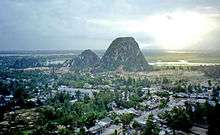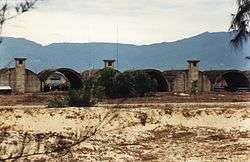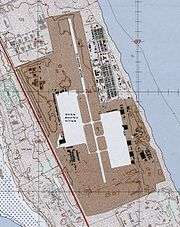Marble Mountain Air Facility
| Marble Mountain Air Facility | |
|---|---|
| Marble Mountains (Vietnam) | |
|
MMAF layout in 1969 | |
| Type | Military air field |
| Site information | |
| Controlled by |
USMC (1965–71) United States Army (1971–72) South Vietnamese Air Force (1972–75) |
| Site history | |
| In use | August 1965 – March 1975 |
| Battles/wars | Vietnam War |
| Marble Mountain Air Facility | |||||||||||||||
|---|---|---|---|---|---|---|---|---|---|---|---|---|---|---|---|
| IATA: none – ICAO: none | |||||||||||||||
| Summary | |||||||||||||||
| Airport type | Military | ||||||||||||||
| Location | Marble Mountain, Vietnam | ||||||||||||||
| Elevation AMSL | 29 ft / 9 m | ||||||||||||||
| Coordinates | 16°01′46″N 108°15′24″E / 16.02944°N 108.25667°ECoordinates: 16°01′46″N 108°15′24″E / 16.02944°N 108.25667°E | ||||||||||||||
| Runways | |||||||||||||||
| |||||||||||||||
Marble Mountain Air Facility (MMAF) (also known as Da Nang East Airfield and Marble Mountain Army Airfield) was an aviation facility used primarily by the United States Marine Corps during the Vietnam War. It was a helicopter facility that was constructed in August 1965 and served as home to Marine Aircraft Group 16 (MAG-16), the 5th Special Forces Group and an assortment of other squadrons until May 1971. It was controlled by the United States Army from May 1971 through August 1972 and finally by the Vietnam Air Force from August 29, 1972 through March 29, 1975 when it fell to the People's Army of Vietnam (PAVN). It was located in Quảng Nam Province 5 miles (8 km) southeast of Da Nang Air Base on a strip of beach between China Beach and the Marble Mountains.
History
On July 28, 1965, President Lyndon B. Johnson announced that the U.S. would increase the number of its forces in South Vietnam from 75,000 to 125,000. The arrival of additional USMC and United States Air Force squadrons at Da Nang AB led to severe overcrowding at the base and the 1st Marine Aircraft Wing (I MAW) began looking for an alternative site for the helicopter squadrons of MAG-16. The Marines ultimately chose a stretch of sandy beach on the South China Sea that was about five miles southeast of Da Nang and just north of a series of red marble mountains for their first helicopter facility. American military construction units were overtasked at the time so the initial construction of the field was done by Raymond, Morrison-Knudson/Brown, Root & Jones (RMK-BRJ). By the end of August 1965, they had completed a 2,000-foot (610 m) runway and on August 26, MAG 16 officially moved in. A week later Military Assistance Command, Vietnam (MACV) would approve the name Marble Mountain Air Facility.[1]

On the evening of 27–28 October approximately 90 Viet Cong attacked MMAF. They attacked under the cover of 60mm mortar fire using four demolition teams armed with bangalore torpedoes and hand grenades. They were able to reach the MAG 16 ramp destroying 19 aircraft and damaging another 35. VMO-2 took the brunt of the attack with thirteen of its UH-1E Hueys destroyed leaving the squadron with only four serviceable aircraft. The attack left two Marines and one Navy Corpsman killed in action with another 91 wounded in action. Forty-one Viet Cong were killed during the battle along with four wounded that were taken prisoner.[2][3]
MMAF also saw the arrival of the first CH-46 Sea Knight helicopters in Vietnam when HMM-164 arrived on 8 March 1966 with twenty-seven aircraft from the USS Valley Forge.[4][5]
On 31 January 1968, on the first day of the Tet Offensive, MMAF received twenty-nine incoming enemy 122mm rockets resulting in one minor injury and minor damage to one CH-53A Sea Stallion and substantial damage to another four CH-53As. Ten CH-46As and eight UH-34Ds also received limited damage. Four VMO-2 UH-1E armed helicopters were launched in defense of MMAF and engaged enemy units.[6]
On 30 April 1969, a Seaboard World Airlines DC-8 airliner with 219 passengers and 13 crewmembers accidentally landed at Marble Mountain when it had actually been cleared to land at the nearby Da Nang AB.[7][8] After fuel was offloaded the aircraft was towed onto the north overrun and departed without incident.
Beginning in 1969 the United States began to draw down its forces in Vietnam and by mid-October all remaining Marine helicopter squadrons were consolidated at MMAF.[9] On 1 June 1971 Marble Mountain Air Facility was turned over to the United States Army.[10]
In February 1971 the 11th Aviation Group was assigned to the 1st Aviation Brigade and redeployed to Marble Mountain. In August 1972 the Group departed Marble Mountain Army Airfield and resettled at Da Nang AB.[11]
Squadrons based at Marble Mountain
The following is an incomplete list of squadrons that were stationed at MMAF during the Vietnam War and the times that they were there:
- Marine Aircraft Group 16 (United States Marine Corps Aviation)
- 16th Combat Aviation Brigade – December 1966 – 1969
- 282nd Assault Helicopter Company – 1966–1970 – "Black Cats/Alley Cats" served at Marble Mountain until approx Dec 1971. Shortly later the company was disbanded.
- 245th Surveillance Aircraft Co. – 1967–1970 – "Redeyes"
- 11th Aviation Group
|
Capture of MMAF
By 26 March 1975 Huế and all of Quảng Trị, Thừa Thiên, Quảng Nam and Quảng Ngãi Provinces had been captured by the PAVN and Da Nang was isolated.[12] Lieutenant General Ngô Quang Trưởng organised his remaining forces, which numbered approximately 75,000 troops, into inner and outer defensive lines around the city, meanwhile the PAVN prepared to attack the city from four directions before its defenses could be properly established. Trưởng's defense plans were hampered by the presence of 1-1,500,000 refugess and ARVN stragglers who had crowded the city.[12]:325 Throughout 26 March evacuation flights by Air America, Air Vietnam, the VNAF and World Airways from Da Nang AB took place but could not keep up with the vast tide of refugees.[13] On 27 March the situation at Da Nang AB was becoming increasingly chaotic as panicked refugees surged to board a World Airways flight and began mobbing the other flights and gathering on the taxiways and runways.[13] By the evening of 27 March all evacuation flights out of the base were stopped, but propeller aircraft continued to evacuate refugees from Marble Mountain Air Facility.[13]:77–8
The PAVN attack began on the morning of 28 March with an artillery barrage on the city, probing attacks quickly penetrated the ARVN defenses, and the fragile ARVN discipline collapsed and soldiers began to desert their positions and seek refuge for themselves and their families. On the night of 28 March General Trưởng received intelligence that an all-out PAVN assault against the city would commence the next morning and he decided to abandon Da Nang and ordered his forces to move to beaches for evacuation by sea.[12]:327–8 The PAVN entered the outskirts of Da Nang by mid-morning on 29 March and by the afternoon were in complete control of the city.[12]:328
Current use

The base remained largely intact until the early 2000s when commercial developments began to encroach upon it. A highway connecting Da Nang and Hội An now runs through the former base and only a few concrete and steel "Wonderarch" aircraft shelters remain.
Notes
- ↑ Fails (1995), p.92-93.
- ↑ "Attack on MAG 16, Hill 22". www.3rdmarines.net. Retrieved 2009-05-06.
- ↑ "Attack on Marble Mountain base information". www.flyarmy.org. Retrieved 2009-05-08.
- ↑ Sherman, Stephen. "Vietnam". History of Marine Corp Aviation. www.acepilots.com. Retrieved February 21, 2007.
- ↑ Marines and Helicopters, 1962 - 1973
- ↑ History information for HMM-363
- ↑ Command Chronology, Marine Air Base Squadron 16, 5 May 1969
- ↑ Seaboard World DC-8 lands at Marble Mountain. YouTube, 7 January 2010. Retrieved 20 January 2012.
- ↑ Simmons (2003), p.242.
- ↑ MajGen John P. Condon (1986). "US Marine Corps Aviation" (PDF). Deputy Chief of Naval Operations (Air Warfare) and the Commander, Naval Air Systems Command. Retrieved 2009-05-06.
- ↑ "11th Aviation Command". History. United States Army Reserve. Retrieved February 17, 2010.
- 1 2 3 4 Veith, George (2012). Black April: The fall of South Vietnam 1973-75. Encounter Books. p. 323. ISBN 9781594035722.
- 1 2 3 Dougan, Clark (1985). The Vietnam Experience: the Fall of the South. Boston Publishing Company. p. 77. ISBN 0939526166.
References
- Bibliography
- Fails, William R (1978). Marines and Helicopters 1962-1973. History and Museums Division – Headquarters Marine Corps. ISBN 0-7881-1818-8.
- Kelley, Michael (2002). Where We Were in Vietnam – A Comprehensive Guide to the Firebases, Military Installations and Naval Vessels of the Vietnam War, 1945–1975. Central Point, Oregon: Hellgate Press. ISBN 1-55571-625-3.
- Simmons, Edwin H. (2003). The United States Marines: A History (4th ed.). Naval Institute Press.
- Stoffey, Bob (1993). Cleared Hot!: A Marine Combat Pilot's Vietnam Diary. St. Martin's Paperbacks. ISBN 0-31292-941-2.
- Web

